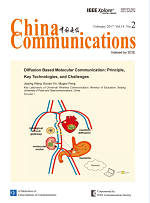COMMUNICATIONS THEORIES & SYSTEMS
Weibing Gong, Xiaolong Yang, Min Zhang, Keping Long
2017, 14(2): 79-89.
CMT (concurrent multipath transfer) can increase throughput and transmission efficiency in multihomed networks. However, it is still an important challenge about distributing traffic adaptively into multiple access networks. Based on LV (Lotka-Volterra) model, we propose an adaptive traffic distribution scheme. In the scheme, two competition modes are concluded, multiple S-D (source-destination) streams competition for bandwidth of one path and multipath competition for traffic between each multihomed S-D host pair. Actually, each access network can establish a path for S-D pairs. So, in the first mode, each path is analogous to a predator, and overall traffic in a multihomed host is analogous to prey. Then, each path has to compete for the traffic by path information, e.g., bandwidth and congestion level. In the other one, if several S-D pairs pass through a shared path simultaneously, they will compete for bandwidth of the path. Here, each S-D pair is analogous to a predator, and the bandwidth of the common path is analogous to the prey. At last, compared with other three schemes, uniform traffic distribution, greedy path selection, random path selection in OPNET simulator, the proposed scheme can perform better on reducing file transmission time and increasing network throughput in FTP service.
